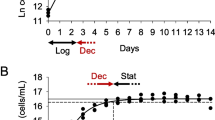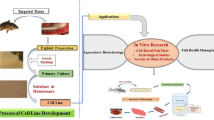Abstract
The aim of this research was a comparative study on the isolation and culture of head kidney macrophages derived from Acipenser persicous and Rutilus frisii kutum as teleost and chondrostei species of fish. The macrophages were isolated by density gradient sedimentation, followed by adherence to a plastic surface. They exhibited strong phagocytic activity against bacteria. The effect of cell density, incubation time, FBS percentage, pH and temperatures on the cell number and viability were determined and compared. Also, the effect of light/dark regimen on viability, adherence, release of reactive oxygen species (ROS) and nitric oxide (NO) in the macrophages was determined. The results showed that the Caspian kutum macrophages were more sensitive to FBS percentage and cell density whereas the Persian sturgeon macrophages were more sensitive to pH of the cell culture media. The adherence and viability of the macrophages from both fish species firstly increased (P < 0.05) after exposure to a light/dark regimen, but then significantly decreased as did ROS and NO productions. For the first time, this study has determined the optimal conditions for primary culture of macrophages derived from sturgeons, and shows the unique effect of light on the biology of fish immune cells.










Similar content being viewed by others
References
Ahmadian E, Malekzadeh-Viayeh R, Zahmatkesh A (2015) Caspian whitefish, Rutilus frisii kutum Kamensky, 1901 a potential aquaculture candidate: study on the cumulative effects of salinity and temperature on culture performance. Iran J Fish Sci 14:623–633
Badhe MR, Nandanpawar PC (1991) An overview of cell culture in fish. Aquatic Fish Database est. http://aquafind.com/articles/Cell-Culture-In-Fish.php
Bahmani M, Kazemi R, Donskaya P (2001) A comparative study of some hematological features in young reared sturgeons (Acipenser persicus and Huso huso). Fish Physiol Biochem 24:135–140
Bemis WE, Findeis EK, Grande L (1997) An overview of Acipenseriformes. Environ Biol Fish 48:25–71
Braun-Nesje R, Kaplan G, Seljelid R (1982) Rainbow trout macrophages in vitro: morphology and phagocytic activity. Dev Comp Immunol 6:281–291
Chebanov MS, Galich EV (2011) Sturgeon hatchery manual, FAO Fisheries and Aquaculture Technical Paper no 558, XXXII, 303 pp (ISBN 978-92-5-106823-6)
Clem LW, Miller NW, Bly JE (1991) Evolution of lymphocyte subpopulations, their interactions, and temperature sensitivities. In: Warr GW, Cohen N (eds) Phylogenesis of immune functions, pp 191–213
Collazos ME, Ortega E, Barriga C (1994) Effect of temperature on the immune system of a cyprinid fish (Tinca tinca, L). Blood phagocyte function at low temperature. Fish Shellfish Immunol 4:231–238
Cossins AR, Crawford DL (2005) Fish as models for environmental genomics. Nat Rev Genet 6:324–333
Couso N, Castro R, Noya M, Obach A, Lamas J (2002) Formation of short-lived multinucleated giant cells (MGCS) from cultured gilthead seabream macrophages. Anat Rec 267:204–212
Cunningham ML, Krinsky NI, Giovanazzi SM, Peak MJ (1985) Superoxide anion is generated from cellular metabolites by solar radiation and its components. J Free Radic Biol Med 1:381–385
Duan R, Liu TCY, Li Y, Guo H, Yao LB (2001) Signal transduction pathways involved in low intensity He–Ne laser-induced respiratory burst in bovine neutrophils: a potential mechanism of low intensity laser biostimulation. Lasers Surg Med 29:174–178
Edwards AM, Silva E (2001) Effect of visible light on selected enzymes, vitamins and amino acids. J Photochem Photobiol B 63:126–131
Elkamel AA, Hawke JP, Henk WG, Thune RL (2003) Photobacterium damselae subsp. piscicida is capable of replicating in hybrid striped bass macrophages. J Aquat Anim Health 15:175–183
Fänge R (1986) Lymphoid organs in sturgeons (Acipenseridae). Vet Immunol Immunopathol 12:153–161
Fierro-Castro C, Barrioluengo L, López-Fierro P, Razquin B, Villena A (2013) Fish cell cultures as in vitro models of inflammatory responses elicited by immunostimulants. Expression of regulatory genes of the innate immune response. Fish Shellfish Immunol 35:979–987
Fraikin GY, Strakhovskaya M, Rubin A (1996) The role of membrane-bound porphyrin-type compound as endogenous sensitizer in photodynamic damage to yeast plasma membranes. J Photochem Photobiol B 34:129–135
Freshney RI (1994) Culture of animal cells: a manual of basic technique, 3rd ed. Wiley, New York, pp 71–103
Garduno RA, Kay WW (1994) Isolation and culture of head kidney macrophages. Anal Tech 3:327
Gordon S, Lawson L, Rabinowitz S, Crocker P, Morris L, Perry V (1992) Antigen markers of macrophage differentiation in murine tissues. In: Russell SW, Gordon S (eds) Macrophage biology and activation. Springer, Berlin, pp 1–37
Green LC, Wagner DA, Glogowski J, Skipper PL, Wishnok JS, Tannenbaum SR (1982) Analysis of nitrate, nitrite, and [15 N] nitrate in biological fluids. Anal Biochem 126:131–138
Hardie L, Fletcher T, Secombes C (1994) Effect of temperature on macrophage activation and the production of macrophage activating factor by rainbow trout (Oncorhynchus mykiss) leucocytes. Dev Comp Immunol 18:57–66
Hazel JR (1984) Effects of temperature on the structure and metabolism of cell membranes in fish. Am J Physiol Regul Integr Comp Physiol 246:R460–R470
Karu T (1999) Primary and secondary mechanisms of action of visible to near-IR radiation on cells. J Photochem Photobiol B 49:1–17
Kim CS, Jung J (1992) Iron-sulfur centers as endogenous blue light sensitizers in cells: a study with an artificial non-heme iron protein. Photochem Photobiol 56:63–68
Kornmann B, Schaad O, Reinke H, Saini C, Schibler U (2007) Regulation of circadian gene expression in liver by systemic signals and hepatocyte oscillators. Cold Spring Harb Symp Quant Biol 72:319–330.
Lannan C (1994) Fish cell culture: a protocol for quality control. Methods Cell Sci 16:95–98
Le Morvan C, Clerton P, Deschaux P, Troutaud D (1997) Effects of environmental temeperature on macrophage activities in carp. Fish Shellfish Immunol 7:209–212
Lubart R, Wollman Y, Friedmann H, Rochkind S, Laulicht I (1992) Effects of visible and near-infrared lasers on cell cultures. J Photochem Photobiol B 12:305–310
Murray PJ, Wynn TA (2011) Protective and pathogenic functions of macrophage subsets Nature reviews immunology 11:723–737
Nicholson BL (1989) Fish cell culture: an update. Adv Cell Cult 7:1–18
Norum M, Bøgwald J, Dalmo R (2005) Isolation and characterisation of spotted wolffish (Anarhichas minor Olafsen) macrophages. Fish Shellfish Immunol 18:381–391
Pottier R, Truscott T (1986) The photochemistry of haematoporphyrin and related systems. Int J Radiat Biol Relat Stud Phys Chem Med 50:421–452
Qiu W, Liu S, Chen J, Hu L, Wu M, Yang M (2016) The primary culture of carp (Cyprinus carpio) macrophages and the verification of its phagocytosis activity. In Vitro Cell Dev Biol Anim 52:10–19
Ribas JLC et al (2014) Effects of anti-inflammatory drugs in primary kidney cell culture of a freshwater fish. Fish Shellfish Immunol 40:296–303
Rodriguez E, Perez M, Casanova P, Martinez L (2001) Effect of seed cell density on specific growth rate using CHO cells as model. In: Lindner-Olsson E, Chatzissavidou N, Lüllau E (eds) Animal cell technology: from target to market. Springer, Dordrecht, pp 434–437
Sarmento A, Marques F, Ellis AE, Afonso A (2004) Modulation of the activity of sea bass (Dicentrarchus labrax) head-kidney macrophages by macrophage activating factor (s) and lipopolysaccharide. Fish Shellfish Immunol 16:79–92
Secombes C (1990) Fish immunology technical communications. Salmonid macrophages and analysis of their killing activity. SOS Publications, Fair Haven
Seeley K, Gillespie P, Weeks B (1990) A simple technique for the rapid spectrophotometric determination of phagocytosis by fish macrophages. Mar Environ Res 30:37–41
Sharp G, Secombes C (1993) The role of reactive oxygen species in the killing of the bacterial fish pathogen Aeromonas salmonicida by rainbow trout macrophages. Fish Shellfish Immunol 3:119–129
Steiro K, Johansen A, Gildberg A, Bøgwald J (1998) Optimising of culture conditions and stimulation of head kidney macrophages from Atlantic cod, Gadus morhua L. J Fish Dis 21:335–344
Suzuki YJ, Forman HJ, Sevanian A (1997) Oxidants as stimulators of signal transduction. Free Radic Biol Med 22:269–285
Uribe C, Folch H, Enriquez R, Moran G (2011) Innate and adaptive immunity in teleost fish: a review. Vet Med 56:486–503
Wang R, Neumann N, Shen Q, Belosevic M (1995) Establishment and characterization of a macrophage cell line from the goldfish. Fish Shellfish Immunol 5:329–346
Wang Y et al (2016) Endotoxin disrupts circadian rhythms in macrophages via reactive oxygen species. PloS one 11:e0155075
Zan-Bar T, Bartoov B, Segal R, Yehuda R, Lavi R, Lubart R, Avtalion R (2005) Influence of visible light and ultraviolet irradiation on motility and fertility of mammalian and fish sperm. Photomed Laser Surg 23:549–555
Acknowledgement
The author thanks Professor Christopher Secombes, Head of the Scottish Fish Immunology Research Centre at University of Aberdeen, and also Dr. Rashid Alijani Ardeshir for helping on experimental work and edition on the manuscript, and also Babol University of Medical Sciences for providing instruments.
Author information
Authors and Affiliations
Corresponding author
Ethics declarations
Conflict of interest
There are no potential or actual conflicts of interest.
Rights and permissions
About this article
Cite this article
Rastgar, S., Movahedinia, A., Salamat, N. et al. Optimization of macrophage isolation from the Persian sturgeon and the Caspian kutum fish: a comparative study. Cytotechnology 70, 1643–1654 (2018). https://doi.org/10.1007/s10616-018-0256-y
Received:
Accepted:
Published:
Issue Date:
DOI: https://doi.org/10.1007/s10616-018-0256-y




